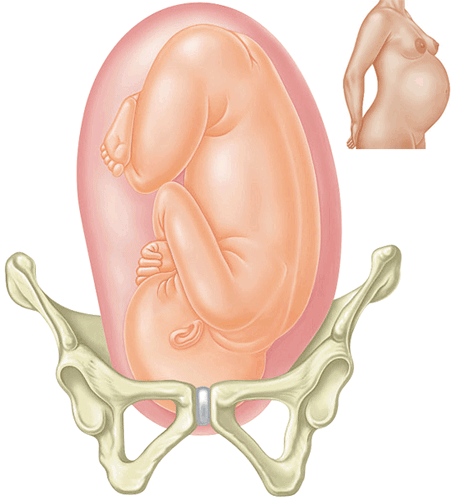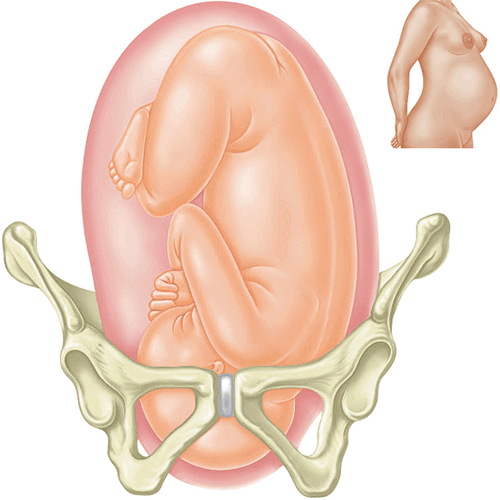Engagement
Engagement is when your
baby's head starts to move down into the pelvic brim in preparation for
birth, and this can occur any time from around 36 weeks until the start
of labor. In the last weeks of pregnancy, your midwife will palpate your
abdomen to see if the head has started to engage. The degree to which a
baby's head is engaged is measured in fifths. If three- or four-fifths
of the head can be felt above the pubic bone, then the baby is not
engaged. If only two-fifths of the head can be felt, then the baby is
said to be fully engaged, and if just one-fifth is felt, the baby is
recorded as being deeply engaged.
Not engaged:
The baby's head has
started to move down into the pelvis, but more than two-fifths of the
head can be felt above the pelvic brim.

Engaged:
The baby has dropped down into the pelvis in preparation for birth and you may notice a change in the shape of your belly.

Birth plan Stating your preferences for labor and birth
The purpose of a birth plan is to communicate your wishes for labor and birth.
Your plan can be as detailed
or as brief as you like. Bear in mind that circumstances may dictate
that not all of your preferences are met. Discuss this plan with your
midwife before the birth. The following are areas you might like to
include:
You may want to state who your birth partner will be, whether you want more than one, and if you want them present throughout.
You
could include your preferences for managing pain. Do you want to labor
as naturally as possible (would like to use a birthing pool), or do you
have a preferred type of medical pain relief?
You
can state which positions you would you like to use? do you want to be
active in the first stage, and in which position would you prefer to
deliver your baby?
Do
you have concerns about being strapped to a fetal monitor? if so, do
you want to request that this be done intermittently only?
State
your preferences for after the birth. Do you want your baby delivered
on to your belly, and how soon do you want to breast-feed?
-

Fetal positions Your baby in the uterus
Your baby can lie within
your uterus in many different positions. Your midwife or doctor will
palpate your abdomen (gently feel your belly) to identify which way your
baby is lying. There are two main positions in which your baby will
lie: with his head downward (cephalic presentation) or with his buttocks
downward (breech presentation). Occasionally your baby will lie across
your uterus in a transverse position or even diagonally across you in an
oblique position, particularly if there is much fluid around the baby
or you have had several babies previously. In about 17 percent of cases,
the midwives and doctors do not identify a breech presentation until
the labor itself.
| Q: |
What is LOA and ROA?
|
| A: |
Once your midwife has identified how your baby is lying, she
will also try to determine whether the baby is lying on your right or
left side. The midwife will track where your baby's back is, and you
will generally feel kicks on the opposite side. The doctor or midwife
will describe your baby as being LOA or ROA, which stands for left or
right occipital anterior—the occiput being the back of your baby's head
facing forward, so your baby is actually facing backward. These are the
best positions for your baby to lie in for labor.
|
| Q: |
What if the baby isn't anterior?
|
| A: |
Sometimes babies lie in a posterior position, which means that
their back is lying against your back and they are looking upward. This
position may prolong your labor, which can be tiring. If this is the
case, you can try the same exercises for turning a breech baby
to encourage your baby to turn to be in an anterior position toward the
end of pregnancy. Sometimes your baby will only turn with the help of
strong, effective contractions when you are in fully established labor.
|
Your baby's position
Myths and misconceptions Is it true that…
| Q: |
The eighth month is the worst?
|
| A: |
Another popular myth is that by the eighth month of pregnancy women start feeling cranky and get irritable. However the truth is that due to high levels of estrogen—which can rev up your libido—some women actually feel great.
|
| Q: |
Men can't feel your pain?
|
| A: |
This is untrue. The father of your baby is probably as concerned about the pregnancy as you are.
Encourage him to share fully in the pregnancy—go to childbirth classes
together, let him talk or sing to the baby and feel your stomach when
your baby kicks!
|
| Q: |
I should eat for two?
|
| A: |
Not true! The average pregnant woman, with one baby, needs to add about 200–300 extra calories a day.
Dieting is not a good idea during pregnancy, but it's also unwise to
eat junk food or to put on too much weight. Just try to follow a
nutritious balanced diet, and eat when you're hungry.
|